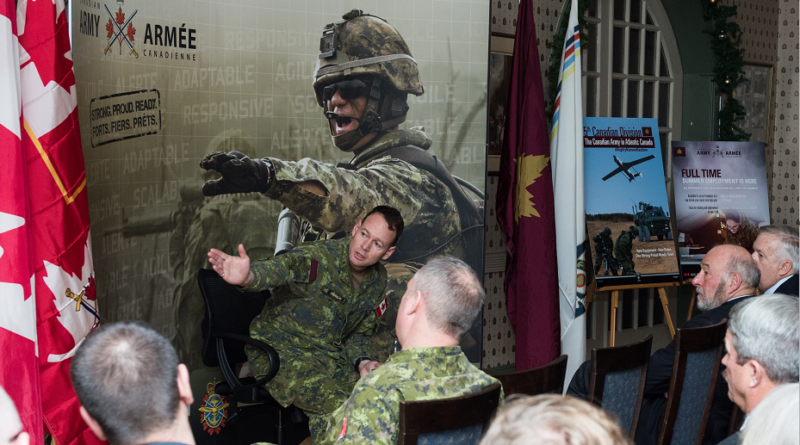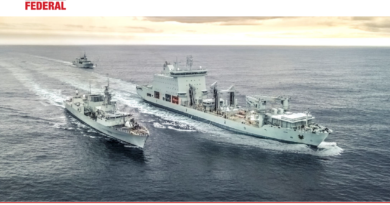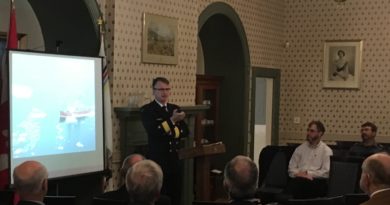5th Canadian Division looks to capitalize on new training, equipment and benefits
Brigadier-General Derek Macaulay, Commander 5th Canadian Division, spoke to RUSI(NS) and guests 10 January 2018 using no notes or slides. His talk was well captured by reporter Ryan Melanson and published by the Trident, newspaper of Maritime Forces Atlantic [https://tridentnewspaper.com/wp-content/uploads/2018/02/2018-02-05-03.pdf]. This article is reproduced with permission.
The senior Army officer in Atlantic Canada identifies diversity, recruitment and retention as among the most important issues facing the organization today, and while recruitment targets for women and visible minorities will take hard work to meet, he says the CAF must remain committed.
“We all know that if we don’t harness the best people, and keep the best people, we won’t be the best. The best means we have to be diverse, and we’re getting there, but we still have a long way to go,” said BGen Derek Macaulay, CO of 5th Canadian Division, speaking to members of the Royal United Services Institute of Nova Scotia on January 10.
The Division is comprised of about 2,000 Regular Force and nearly 3,000 Reserve Force members spread out over 27 units and five bands in 30 different communities throughout New Brunswick, Nova Scotia, Prince Edward Island and Newfoundland and Labrador, along with the Canadian Combat Support Brigade in Kingston, Ontario, which is now under 5 Cdn Div command. Also included is the 5th Canadian Ranger Patrol Group in Newfoundland and Labrador, and about 1,000 civilian employees across the different units.
Since taking command of the division last spring, BGen Macaulay said he’s learned retaining members is a challenge across 5 Cdn Div units. To be successful, the Army must be able to hold on to enough of its current soldiers while it brings in new blood, he said.
“That’s going to become a problem in the near future. We need to figure out ways to keep our soldiers in.”
He spoke about a number of potential solutions or recent changes that might encourage personnel to continue serving, including some that stem from Canada’s new defence policy and an increased focus on the wellbeing of CAF members and their families. For part-time members, new summer employment opportunities can guarantee 12 weeks of full-time paid work through the first four years of service, and yearly tuition reimbursements of $2,000 are also available for soldiers pursuing post-secondary studies. BGen Macaulay said he’s putting a focus on ensuring members are aware of these potential benefits and have access to any help needed to take advantage of them. Keeping civilian employers aware of the training and skills provided by the Army, and how they can be transferable to the workplace, can also help prevent potential reservists from having to choose between a civilian or military career, he said.
There also exists a propensity for Atlantic Canadians to want to stay close to home, and in a region where employment numbers sometime lag behind the rest of the country, that presents an opportunity to keep soldiers happy.
“If we can allow people to stay here, grow their families here, and retire here, we should be doing that,” BGen Macaulay said.
New equipment and new roles for Army Reserve units should also help inject some excitement and morale into the Division. He stressed that the Army’s new Tactical Armoured Patrol Vehicles are not strictly for the Regular Force, and more than 100 of the 500 total new TAPVs will be allocated to Reserve units across the country. Another new piece of kit, the Boeing Insitu Blackjack UAV, is currently in the hands of 4 Regt (GS) and will eventually be integrated into other 5 Cdn Div units.
Newly assigned roles for the Army Reserve will soon see units focus on one of four specific taskings – direct fire support, mortars, pioneers, and light urban search and rescue. Those changes, along with the training and equipment that come with them, will begin this summer.
“Those units will get additional full-time soldiers posted in to develop those capabilities, and it means when the full-time force needs that capability, they’re coming to those units to get it,” BGen Macaulay said.
“The integration is exciting, and I think it’s what our part-time units want.”
But he still expects difficulties ahead in finding and retaining talent for 5 Cdn Div and the CAF as a whole, and said he and other senior leaders will continue to explore different ways to grow and diversify the ranks.
What’s certain, he said, is that the part-time and full-time units under his command will remain operationally ready and committed to serving at home and abroad.
“Over these four provinces, we see a lot of men and women who give their heart and soul to this uniform and are very proud to wear the Canadian flag on their shoulder. The soldiers are in our communities, they’re training, and they’re ready.”
A PDF of this article is available here.




